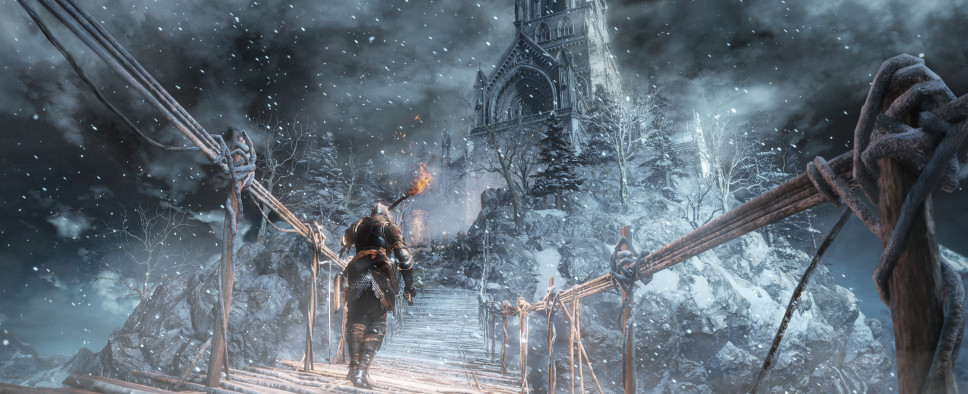Dark Souls III + Ashes of Ariandel DLC Review
-
Category: ReviewsHits: 21860

Article Index
In my experience, performance is also not spotless, even though the game is not a technical marvelhouse, and the framerate cap is only 60 fps, which will inevitably disappoint owners of high-refresh monitors. The silver lining is that, this time around, playing at 60 fps doesn't cause any bugs, and the experience is in line with consoles while also being much smoother. Keyboard and mouse controls are also pretty decent, but unfortunately the game only provides controller prompts, for no discernible reason. It's a strange oversight that doesn't hurt the experience but slightly cheapens it. All that said, I'd still say that the Dark Souls III PC port is a very good way to experience the title.
Conclusions
If you wanted Dark Souls III to surprise you and make you feel like when you discovered Demon's Souls, then you'll inevitably be disappointed. The ship has sailed in that sense, and there's no knowing whether From Software or another developer will capture the same spark with a new franchise. That said, there is no doubt that, even when realistically approached as a sequel, Dark Souls III is a very conservative game.
Can a victory lap be an excellent game, then? Yes, undoubtedly. And after a string of excellent games, From Software has certainly earned the right to self-indulgently celebrate its triumphs. Should another Dark Souls title come out and refuse to innovate on the formula, I'll be more disappointed. For now, I'll still enjoy Dark Souls III. I'm not blind to what it is, but what it is is still great indeed.
Dark Souls III: Ashes of Ariandel
Let's start with the negatives. The recently released Ashes of Ariandel is, without a doubt, the worst piece of downloadable content for a From Software game. Dark Souls and Dark Souls II all received downloadable content of higher quality, and all reports point to Bloodborne's DLC as also excellent, though I haven't played that one yet. That said, if we take a step back and consider the high level of quality of the content released so far, this is in my opinion less of a problem than it might seem at first.
Ashes of Ariandel adds a completely new, separate area, that can be accessed near the middle of the game, but is meant to be completed by endgame characters. It's a new Painted World, yet another callback to the original Dark Souls, but one that goes in a very different direction, gameplay and story-wise. Where the Painted World of Ariamis focused on the same kind of spaces as the main game, the Painted World of Ariandel employs a strong blizzard effect to make its wide spaces seem even wider.
It can be daunting to explore at first, given the combination of wide open fields and limited visibility creates the impression of an open world, but it avoids the pitfalls of similar previous experiments in the series, like the Frigid Outskirts in Dark Souls II: Crown of the Ivory King. Eventually, open fields give way to a small township and a number of interiors, in a way that is not at all dissimilar to the progression in Artorias of the Abyss, the lauded expansion for the original Dark Souls. In fact, both Ashes of Ariandel and Artorias of the Abyss share many of the same limits and many of the same qualities, though in different measures.
In both of the downloadable expansions, the open fields can quickly become exhausting. Where Ashes of Ariandel succeeds while Artorias of the Abyss failed, is in its enemy placement and the abundance of secrets available. There are plenty of hidden items, crevices and secret encounters, which, while often holding only mediocre loot, are very rewarding to find. Enemies also feel placed more carefully, often either in packs of easy enemies that compensate each other weaknesses, or as single strong enemies that can be avoided or fought with ease due to the ample space available. The tension is kept constantly high, however, which feels tiresome on the long run, and the DLC would have benefited from a slower introduction to give the player a taste of the enemies' abilities, so that they could more easily formulate a counterattack plan when pitted against groups of them.
In other areas, however, Artorias of the Abyss still takes the crown. Oolacile Township, for example, is a much more accomplished area than the comparable Corvian Settlement, which can feel rather short and unrewarding to explore due to its overtuned encounters. Bosses are also somewhat interesting as a matter of comparison. So far, I've only mentioned Artorias of the Abyss, but it's worth noting that every single Dark Souls DLC previously released features more bosses than Ashes of Ariandel. While sometimes Dark Souls II's downloadable content would resort to recycled and slightly tweaked creatures to up its boss count, those bosses can easily be compared to Dark Souls III's DLC only optional boss, the Champion Gravetender, a fight that is only slightly more polished and features some rather overplayed mechanics.
The final boss of Ashes of Ariandel is comparatively a much more accomplished fight. Indeed, if judged simply based on its moveset and the amount of work that went into it, it would be one of the best bosses in the series. I can't personally share that opinion, though, and there is a simple reason for that. Dark Souls bosses have to walk a fine line, especially all these years after the release of Demon's Souls. Players understandably expect them to be polished and exciting on all fronts, from the visuals to the mechanics, and most importantly, they expect them to be challenging.

